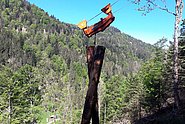Sustainable regeneration of silver fir (Abies alba Mill.) is important for maintaining and improving the future resilience and protective capacity of mountain forests in the southern Swiss Alps. However, increasing densities of wild ungulates, such as red and roe deer, can hamper the regeneration success of silver fir. A comprehensive understanding of forest–wildlife interactions is essential to plan concrete measures for improving the adaptation potential of mountain forests. Here, we monitored the dynamics of natural silver fir regeneration in mountain protective forests. This study encompassed 30 unfenced permanent plots across two sites, Lostallo and Soazza, located in Valle Mesolcina in the southern Swiss Alps. These sites were selected for their comparable ecological characteristics related to silver fir regeneration, yet contrasting densities of mature, seed-bearing silver fir trees. We recorded the number of seedlings (<10 cm height) and saplings (10–200 cm height), and repeatedly assessed height growth, frequency, and intensity of ungulate browsing on saplings in the summers 2016, 2019, and 2022. In 2022, we additionally recorded the presence of browsing on other tree species in the unfenced plots and the height growth increments of silver fir saplings in pre-existing fences. On average, 509 silver fir seedlings/ha were present in the study area, but there was a lower density of saplings (382 saplings/ha). Between 2016 and 2022, the browsing frequency on silver fir saplings increased from 33 per cent to nearly 100 per cent, accompanied by a significant rise in browsing intensity. Furthermore, sapling height growth from 2019 to 2022 was significantly reduced or even negative in the unfenced plots as compared to the growth of saplings in the fenced plots. The observed seedling density indicated a good potential for natural regeneration of silver fir, irrespective of the differences in the density of seed-bearing trees between the two sites. However, the increased ungulate browsing impaired successful regeneration in the considered mountain forests in the southern Swiss Alps. Thus, without an effective control of ungulate browsing, silver fir may not be able to substantially contribute to the transition to more resilient and future-proof mountain forests.
See DOIVoir Institutional Repository DORA

